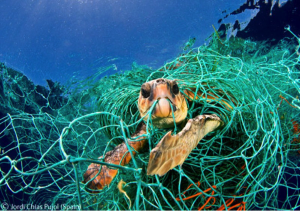SAN JOSE — A dynamic and novel approach is needed to reduce the accidental catch of pelagic predators, such as the leatherback sea turtle, in the world’s fishing grounds, according to Stanford biologist Larry Crowder.
The current system in place to restrict the unintentional capture of large ocean predators includes regulations such as Marine Protected Areas (MPAs) and fishing gear restrictions. At the American Association of the Advancement of Science annual meeting in San Jose on Feb. 13, Crowder presented a more dynamic way of looking at ocean management that would restrict fishing in certain designated areas by taking into account the movement of both the protected species and fishermen.
“This idea was suggested about 15 years ago … and when I read the [original] paper, to be honest, I thought it was [wasn’t feasible]. It was something that just couldn’t be done … and now in 2015 we are exploring very seriously this concept,” said Crowder, who is the director of Stanford’s Center for Ocean Solutions Science.
The accidental capture of non-targeted species — known as bycatch — is a fundamental problem facing world fisheries. Tuna, swordfish and other highly migratory species are extremely valuable to the world’s economy, yet their commercial fishing results in high amounts of unintended catch, said Crowder
Finding a balance between protecting seabirds, turtles and mammals while also maintaining viable and prosperous fisheries is of critical importance, he said.
The current system in place to protect against the unwanted catch of marine animals includes spatial management to close off designated areas of the ocean. However most MPAs are fixed, meaning they don’t change season to season. Current MPAs are also primarily coastal. This combination results in a static protection system that takes a long time to change.
The ocean, however, is not static, Crowder said. It is a dynamic structure operating in multiple dimensions. The migratory patterns of marine animals based on food sources or “buffet lines” are well known and respond to seasonal shifts.
MPAs based on the movement of pelagic species would create an autonomous control system that would respond to the changes in oceanography and provide the same protection but leave more of the ocean open for fishing; a small precise tool rather than broad sweep.
Crowder said we have the technology to make this feasible. Satellite tags have become less expensive and they allows scientists to track when and where animals are feeding. And, thanks to advances in remote sensing, scientists have a better picture of physical features of the ocean. By comparing the satellite tracks of species to the topography of the seafloor scientists can create a dynamic, three-dimensional model of the movement of species.
A change to laws governing where they could fish would not be a dramatic shift for fishermen because they already use real time technologies to track where to fish. “The pilot house of [a commercial fishing] vessel looks like NASA.” joked Crowder.
Despite the positive outlook, dynamic ocean management has yet to be explored outside laboratory modeling. But scientists spearheading the idea believe that the U.S. coastal fishery extending from Canada down to Baja California would make a suitable prototype to experiment with the new tool.
Caroline Atwood is a junior at Williams College majoring in geoscience with a minor in maritime studies. She hails from the Green Mountain State, but loves writing about all things ocean. Email her at Caroline.Atwood27@gmail.com

